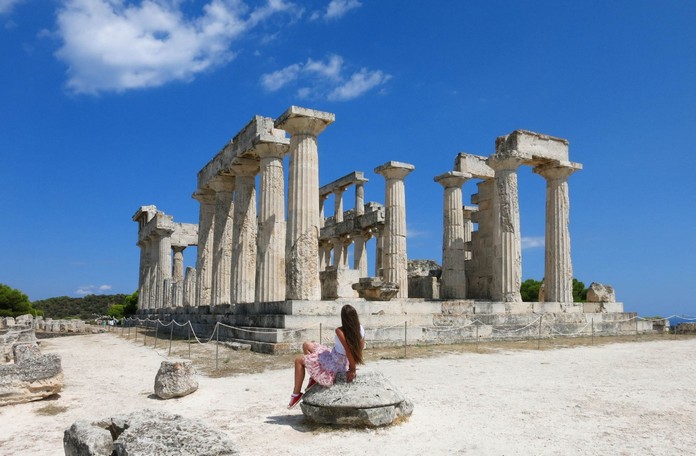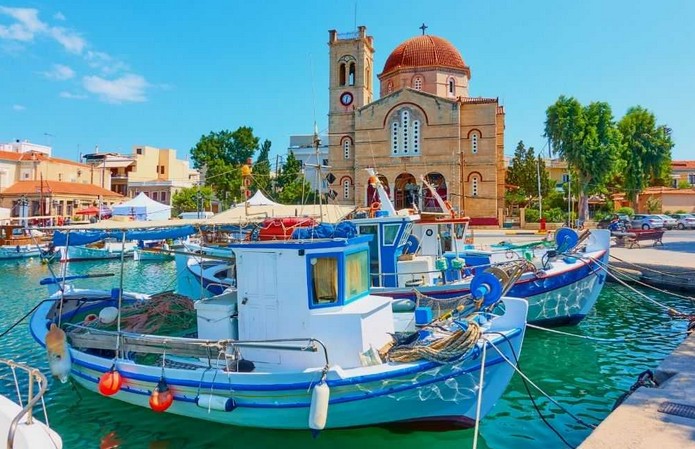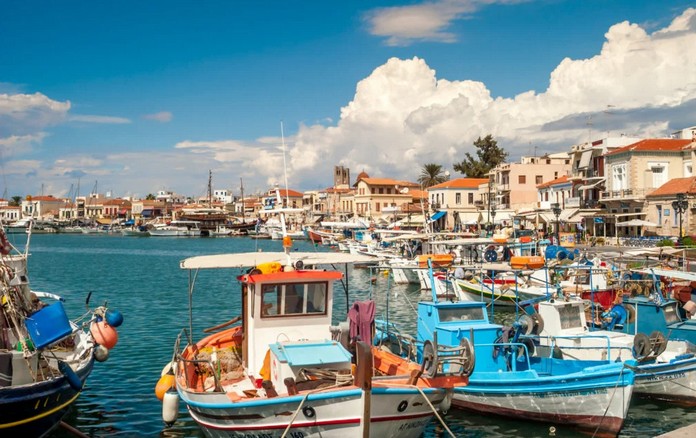When we think about Aegina, what springs to mind is a pine-covered island with a hill on which the fine ancient temple of Aphaia stands dominant. If one draws an imaginary straight lines linking this temple with the Parthenn and the temple of Poseidon on Cape Sounion, the result is an almost equilateral triangle whose vertices gaze at each other and constitute the most beautiful items that Attica has had to show since ancient times.
Below the temple of Aphaia are attractive bays and sandy beaches, and although much of Aegina is built on; this is certainly less the case than it is with Salamina.

Aegina- the second largest of the islands of the Argosaronic gulf lies in the center of the gulf and has an area of 85sq km and a shoreline of 57km.
The main occupation of its prominent residents is the growing of pistachio nuts.
The “Aegina pistachio” is famous and is the island;s most important product.
However, apart from the permanent residents, there are others, the Athenians, who have a second home or a luxury villa on Aegina and come here almost all year round.
Aegina lies only 16 nautical miles from Piraeus and the crossing by the ships or ferries which provide a daily service takes only an hour.
There are also “flying dolphin” hydrofoils which cut this time down to half an hour. In addition, those who are not content with Aegina alone and want to explore other shores, the same services make it possible to visit the other islands of the Argosaronic gulf (Poros, Hydra and Spetses) or go to Methana, Ermioni or Porto Heli- or ata greater distance, to Tolo and Nafplio. It has to be noted that some of these services are less frequent or completely non-existent in winter.

The above applies to the main port of Aegina, because there are also boat services from Piraeus direct to Souvala on Aegina and in summer, direct to Agia Marina with its fine sandy beach. From the port of Aegina, the local buses provide a regular and easy means for the visitor’s sightseeing of the island.
History
Mythology tells us that the first king of the island was Aeacus, son of Zeus and the nymph Aegina, who renamed the island which had been called Oenone, in honor of his mother.
Aegina was inhabited in the Neolithic period, as can be seen from the finds at Kolona, near the town of Aegina, which date from around 3000 BC. Later the Minoans came to the island, to be followed by the Achaeans and Dorians.
From the middle of the second millenium BC, Aegina began to develop its trade and at the same time emerged as a naval power. Its vessels took its products, mainly ceramics, to the Cyclades, Crete and mainland Greece. It reached the zenith of its development in the 6th century BC when, as an independent power, was the first city in Greece to mint coins.
In spite of the fact that Aeginawas a rival of Athens and Piraeus, it helped the Athenians at the battle of Salamis. However, the Athenian who never trusted it, finally seized it in the middle of 5th century.
Aegina made an important contribution to the struggle against the Turks in 1821 and was the seat of the first Greek government under Kapodistria before being succeeded in this role by Nafplio.

Getting to know the island
The picturesque port of Aegina immediately gives the visitor the feeling of being on an island. The breakwater with its chapel, the old houses, many of which are surprisingly well-preserved, the little boats, the caiques, the busy waterside- all make a cheerful picture calculated to put the visitor in a mood to enjoy the island.
The town of Aegina has much for the visitor to see: the Archaeological museum, Kolona. the remains of the ancient temple of Apollo near the harbour, the cathedral in which the first Greek government after the War of Independence was sworn in and the first Greek Governor’s residence. 1.5km away from the town is the Church of St. Theodore dating from the 13th century with fine wall paintings.
There are a number of sights outside of the town. First and foremost among these is the temple of Aphaia dedicated to an ancient goddess who was the protector of the island. The temple is in the Doric style and was built after the battle of Salamis (480 BC) on an idyllic site with a view over the sea with the shores of Attica in the distance. You can end up at the fine sandy beach of Agia Marina 3.5km away, which has full tourist facilities.
There are also nice beaches on the island’s northern coast like Souvala and Vaia as well as on the west coast Faros and Marathonas. The road which passes through Faros and Marathonasends at the picturesque village of Perdika.which looks out on the pine-covered islet of Moni with sandy beaches and a camping site.
In the interior of the island, about half way along the road to the temple of Aphaia, on the left is Paleochora, a ruined medieval village built as a refuge from pirates for the people of the island and the Nunnery of St. Nektarios, in which the saint to which it’s dedicated lived for the last years of his life and which houses his relics.
The feast day of the Nunnery is November 9th and attracts a large number of pilgrims. Another religious house, Lady Chrisoskalitissa, stands near the village of Tzikides. If you continue along the road to the south east from this village, you will come to Pacheia Rachi, a village on the foothills of the conical Oros, Aegina’s highest mountain. Near its summit it has the remains of a sanctuary to Zeus Hellanius.